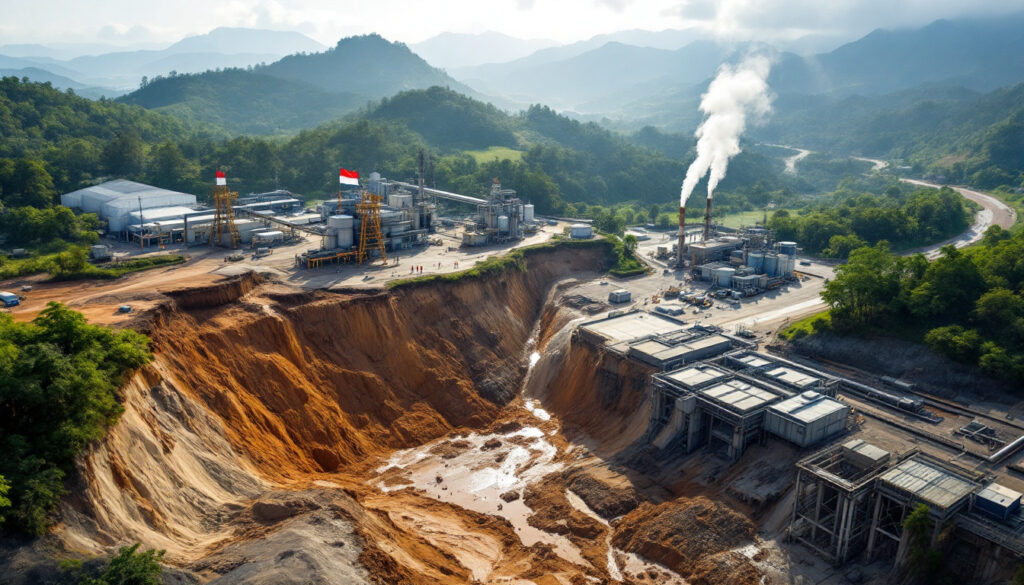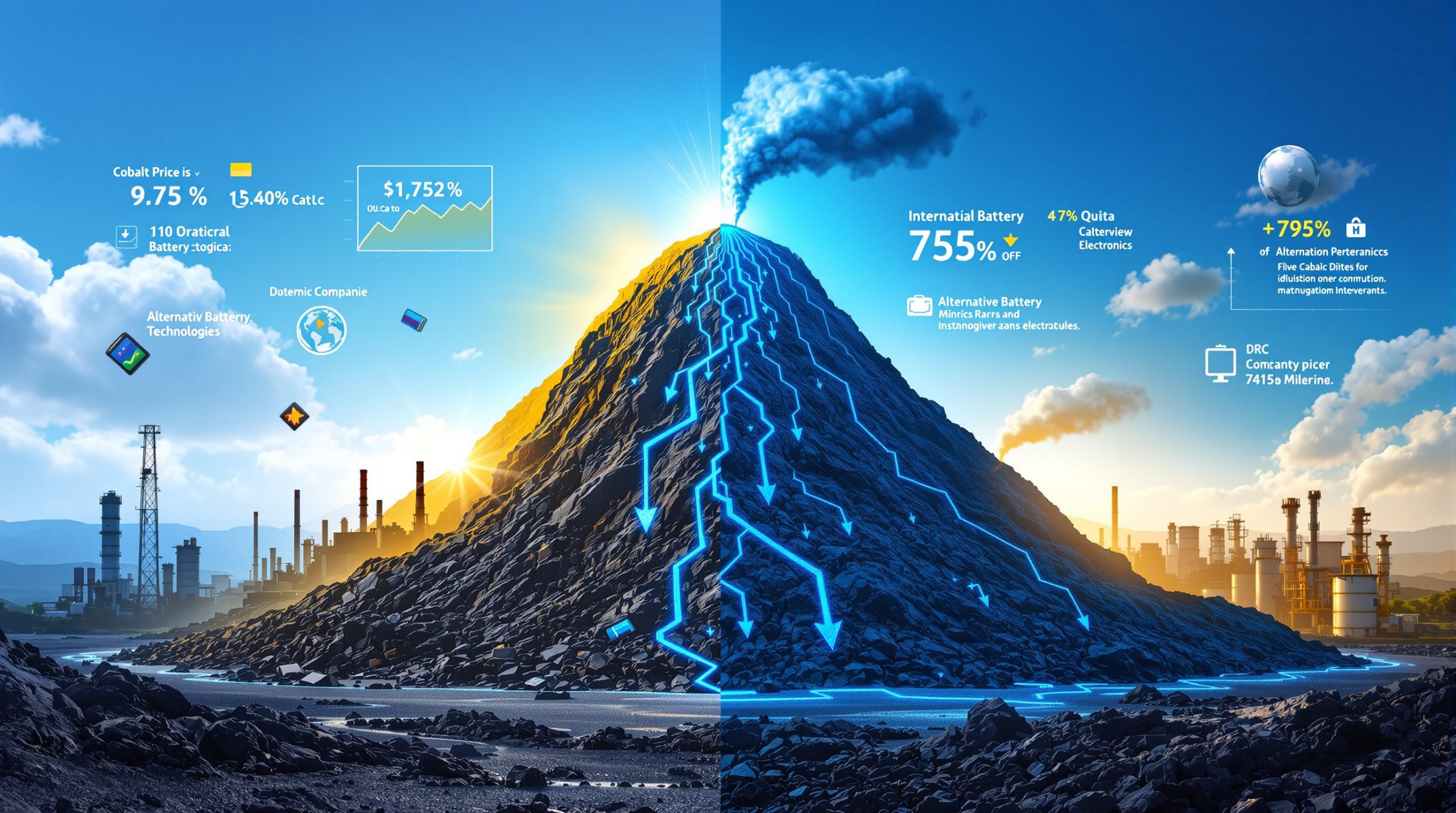Nickel Production Disruption in Indonesia: Impact on Global Supply Chain
The recent landslide at Indonesia's Morowali Industrial Park has exposed critical vulnerabilities in the global nickel supply chain, which relies heavily on the country's dominance in nickel processing. With Indonesia contributing over 50% of global nickel output, the incident underscores the risks of concentrated production hubs utilizing high-pressure acid leaching (HPAL) technology. The immediate production halt at PT QMB New Energy Materials and reduced output from neighboring facilities have already triggered concerns about short-term supply volatility, particularly for electric vehicle (EV) battery manufacturers dependent on Indonesian nickel. Long-term implications include potential regulatory reforms, increased scrutiny of HPAL waste management practices, and a possible shift toward supply chain diversification.
What Happened at Indonesia's Morowali Industrial Park?
The Landslide Incident
A devastating landslide occurred in March 2025 at a tailings area associated with PT QMB New Energy Materials, claiming two lives with one worker still missing. The disaster struck within Indonesia's Morowali Industrial Park on Sulawesi Island, a critical hub for nickel production disruption in Indonesia that supplies global markets. PT Indonesia Morowali Industrial Park (IMIP), which manages the industrial complex, attributed the catastrophe to unusually heavy rainfall that had saturated the ground over several weeks.
The incident site is located in a region responsible for approximately 15% of Indonesia's massive nickel output, processing both lateritic nickel ore for stainless steel production and lower-grade limonite ore for electric vehicle batteries through HPAL technology. Geological surveys conducted after the landslide revealed that improper drainage systems and insufficient structural reinforcement contributed to the collapse.
Immediate Production Impact
The aftermath saw an immediate production halt at PT QMB New Energy Materials facility, while neighboring producers in the industrial park reduced their output by approximately 20-30% according to confidential industry sources. Before the disruption, QMB had shipped more than 25,000 tonnes of nickel in Q1 2025 alone, representing about 8% of the park's quarterly output.
GEM, which holds the largest stake in QMB, issued a statement claiming the production decline was primarily related to scheduled maintenance and holiday closures, likely an attempt to minimize market concerns. However, satellite imagery analysis from mining consultancy firm SulawesiMine shows significant operational reductions across multiple facilities in the area, contradicting these official statements.
Industry insiders reveal that operations could remain curtailed for up to three months as safety inspections and reinforcement work is completed. The estimated production loss could reach 35,000-40,000 tonnes of nickel equivalent by mid-year, creating significant supply constraints for downstream manufacturers.
Why Is Indonesia Critical to Global Nickel Supply?
Indonesia's Dominance in Nickel Production
Indonesia has rapidly ascended to become the undisputed global nickel powerhouse, accounting for more than 50% of worldwide nickel output. This meteoric rise stems from the country's aggressive expansion of processing capacity over the past decade, transforming from a raw ore exporter to a vertically integrated producer of refined nickel products.
The nation possesses approximately 21 million tonnes of nickel reserves, representing nearly a quarter of global reserves. What makes these reserves particularly valuable is that roughly 60% consists of limonite ore suitable for HPAL processing into battery-grade nickel sulfate. Morowali Industrial Park serves as the central hub for this expansion, hosting 48 nickel processing facilities that collectively account for 30% of Indonesia's production capacity.
Chinese investment has been instrumental in accelerating Indonesia's nickel sector development, with an estimated $30 billion flowing into the country's nickel industry between 2018-2025. Furthermore, China's export restrictions on certain battery technologies have further complicated the global supply chain dynamics. This partnership has enabled the construction of integrated supply chains from mining to battery-grade materials production within a compressed timeframe that would typically require decades of development.
Strategic Importance for Battery Supply Chain
Indonesian nickel has become the linchpin of the global electric vehicle battery supply chain. The country hosts 15 operational HPAL plants producing approximately 450,000 tonnes annually of mixed hydroxide precipitate (MHP), the critical precursor for battery-grade nickel sulfate used in high-energy density cathodes.
EV manufacturers face significant risk from these supply disruptions, as nickel-containing batteries (particularly NMC chemistry) deliver 20-30% greater energy density than alternatives. A single high-end electric vehicle can require up to 40kg of nickel in its battery pack, making consistent supply essential for production planning.
"Indonesia's nickel infrastructure expansion has prioritized speed over safety protocols, creating systemic risks that are now becoming apparent," notes Putra Adhiguna from the Energy Shift Institute. "The rapid development timeline has compressed what would normally be years of gradual technical improvements and safety protocol development into just a few years."
The country's strategic position has become so dominant that analysts estimate a three-month disruption at Morowali could delay global EV production targets by 2-5% for 2025, highlighting the dangerous concentration risk that has developed in this critical mineral supply chain. Understanding these dynamics is essential for those investing in mining stocks across the battery materials sector.
What Are the Concerns About HPAL Technology in Indonesia?
High-Pressure Acid Leaching (HPAL) Challenges
HPAL technology has enabled Indonesia to process previously uneconomical low-grade nickel resources, but this advancement comes with significant technical and environmental challenges. The process, which operates at temperatures exceeding 250°C and pressures above 40 bar, utilizes sulfuric acid to extract nickel and cobalt from ore with nickel content as low as 1%.
While cost-effective and less carbon-intensive than traditional pyrometallurgical methods for processing low-grade ore, HPAL generates 8-10 tonnes of tailings per tonne of nickel produced, compared to 4-5 tonnes from rotary kiln electric furnace (RKEF) processing. Indonesia's HPAL facilities consume 250-300 kWh of energy per tonne processed, approximately 30% higher than global averages due to heavy reliance on coal power.
PT QMB's HPAL plant employs a proprietary sulfuric acid recovery system that reduces operational costs by approximately 15% but increases corrosion risks in certain components. This tradeoff between economic efficiency and equipment integrity exemplifies the engineering compromises made during rapid scale-up.
Indonesia has launched approximately 10 HPAL plants in the past five years, with limited technological transfer and adaptation to local conditions. Most facilities were designed based on experiences in different geological and climatic settings, potentially overlooking the unique challenges posed by Indonesia's tropical environment.
Safety and Environmental Implications
The recent landslide starkly highlights the waste management challenges associated with HPAL technology in Indonesia's tropical climate, which receives an average annual rainfall of 2,500-3,000mm. The region's frequent seismic activity compounds these risks, as even minor earthquakes can compromise tailings dam integrity.
This incident is not isolated, as demonstrated by a 2023 explosion at a Morowali smelter that killed 21 workers. Environmental monitoring by independent consultants has detected elevated levels of heavy metals in waterways surrounding several HPAL operations, including nickel, chromium, and manganese concentrations exceeding Indonesian environmental standards by 3-7 times.
"These are not isolated incidents but reflect broader industry problems," warns Putra Adhiguna. "The combination of rapid development, complex processing technology, and challenging environmental conditions creates a perfect storm for industrial accidents."
Local communities have reported declining fish populations and crop yields in areas downstream from HPAL operations, suggesting wider environmental impacts that have yet to be fully quantified or addressed. Without more robust waste management protocols, the long-term environmental footprint of Indonesia's nickel boom could prove devastating for local ecosystems and communities. Industry analysts are increasingly factoring these mining ESG challenges into their assessment of operational risks.
How Are Authorities Responding to the Crisis?
Regulatory Investigation and Safety Measures
The Indonesian government has launched a comprehensive investigation into the accident, with preliminary findings indicating inadequate slope stabilization measures at the tailings site. Safety factors were reportedly below the 1.5 minimum required by Indonesian Regulation No. 26/2018 on mine reclamation and closure.
PT IMIP has announced an ambitious program to improve standards and reduce geological disaster risks, allocating approximately $120 million for reclamation efforts. Planned improvements include extensive terracing, upgraded drainage systems, and reforestation of surrounding slopes to improve soil stability.
Industry sources confirm that QMB will likely experience significantly reduced output through April and possibly into May due to the ongoing investigation and remediation work. The Ministry of Energy and Mineral Resources has deployed a technical team to evaluate all similar tailings facilities across the country, with interim reports expected within 60 days.
The 45-day production suspension at PT QMB is projected to result in an 8,000-tonne output loss, while neighboring facilities have implemented a 20% reduction in production for Q2 2025 as a precautionary measure during safety reviews.
Industry-Wide Implications
The incident may trigger increased scrutiny of all HPAL operations in Indonesia, particularly those utilizing similar tailings storage designs. Regulatory authorities are considering implementing more stringent geological stability requirements, waste management protocols, and emergency response planning.
This regulatory response comes at a critical juncture as the Indonesian Mining Association recently called on the government to reconsider royalty rate increases planned for implementation in 2026. Industry representatives argue that additional financial burdens could undermine investments in safety infrastructure, creating a tension between revenue generation and operational standards.
Environmental groups have seized on the incident to advocate for a comprehensive review of all nickel processing permits, particularly those granted through expedited processes during the rapid expansion phase. Their proposals include mandatory third-party safety audits and increased community consultation requirements.
Industry analysts suggest that increased regulatory oversight could extend project development timelines by 12-18 months and add 8-12% to capital expenditure requirements for new facilities, potentially slowing Indonesia's ambitious expansion plans. A deadly landslide in Indonesia's nickel hub has heightened concerns about safety throughout the industry.
What Does This Mean for Global Nickel Markets?
Short-Term Supply Disruptions
The immediate market impact has been substantial, with London Metal Exchange (LME) nickel prices surging 12% to $23,500 per tonne following the incident. Battery manufacturers report 2-3 week delays in MHP shipments, potentially affecting Q3 2025 EV production schedules.
Market observers note that the disruption comes at a particularly sensitive time as global automakers are ramping up EV production to meet increasingly stringent emissions regulations in Europe and China. Battery cell manufacturers typically maintain only 4-6 weeks of nickel precursor inventory, creating limited buffer against sustained supply interruptions.
Trading houses report increased interest in Class 1 nickel from traditional sulfide operations in Canada and Australia as manufacturers seek to diversify supply. However, these alternative sources command a 15-20% premium over Indonesian material and cannot fully replace the volume shortfall in the near term.
Spot market premiums for battery-grade nickel sulfate have increased by 25-30% since the incident, reflecting tight availability and concerns about continued disruptions. Chinese battery manufacturers, who rely on Indonesian nickel for approximately 65% of their raw material requirements, are particularly vulnerable to these supply constraints.
Long-Term Industry Outlook
The crisis raises fundamental questions about the sustainability of Indonesia's rapid nickel sector expansion model. New tailings regulations being considered could raise Indonesian nickel production costs by $500-$800 per tonne, eroding the current $2,000 per tonne cost advantage over Canadian and Australian producers.
Approximately 20 new HPAL projects currently under review face potential delays pending safety audits and regulatory clarification, potentially slowing the projected supply growth that many analysts had factored into their mining industry predictions for 2026-2027.
Major battery and automakers are accelerating research into nickel-free lithium iron phosphate (LFP) batteries, which could capture 45% of the EV market by 2030 if HPAL risks persist. This technological shift would represent a significant long-term threat to nickel demand growth projections.
The incident may also accelerate efforts to develop alternate nickel resources in more stable jurisdictions, with increased exploration activity reported in Australia, Canada, and Brazil. However, these projects typically require 5-7 years from discovery to production, meaning Indonesian dominance will likely persist through this decade despite the current challenges. For a broader perspective, experts recommend following global commodities insights as the situation continues to evolve.
FAQ: Indonesia's Nickel Industry Disruption
How significant is Indonesia to global nickel supply?
Indonesia produces more than half of the world's nickel, making any disruption to its production a significant concern for global markets. The country has transformed from primarily exporting raw ore to becoming an integrated processor producing various grades of nickel for both stainless steel and battery applications. This concentration creates substantial supply chain vulnerability, as evidenced by the market's strong price reaction to the recent incident.
What is HPAL technology and why is it controversial?
High-Pressure Acid Leaching (HPAL) is an advanced hydrometallurgical process that allows for the processing of lower-grade nickel ore (typically 1-1.5% nickel content) that would be uneconomical with traditional methods. The technology uses high-temperature, high-pressure sulfuric acid to dissolve nickel and cobalt from lateritic ores.
While HPAL is cost-effective and produces battery-grade materials with lower carbon emissions than pyrometallurgical alternatives when processing low-grade ore, it generates nearly twice the amount of tailings waste compared to traditional smelting methods. These tailings contain residual acids and heavy metals that require sophisticated containment and neutralization systems. The technology's rapid deployment in Indonesia has outpaced the development of adequate waste management infrastructure, creating significant environmental and safety risks.
Who are the key stakeholders in the affected facility?
PT QMB New Energy Materials' primary shareholders include GEM (36%), Tsingshan Holding Group (21%), Brunp Recycling Technology (25%), and several minor partners. GEM, as the largest shareholder, is a prominent Chinese battery recycling and materials company with significant supply contracts to major EV manufacturers.
The facility operates within the Morowali Industrial Park managed by PT Indonesia Morowali Industrial Park (IMIP), a joint venture between Tsingshan and several Indonesian partners. IMIP provides infrastructure, power, and logistics services to multiple nickel processors within the industrial complex, creating an integrated production hub that optimizes operational efficiency but also concentrates risk.
What measures are being implemented to prevent future incidents?
PT IMIP has announced comprehensive plans for land reclamation, terracing, improved drainage systems, and reforestation to reduce geological disaster risks at all tailings facilities within the industrial park. These measures focus on improving structural stability during Indonesia's intense rainy season.
The ongoing government investigation is likely to result in more stringent requirements for tailings dam construction, including increased factor-of-safety margins, enhanced monitoring systems, and more conservative design parameters for extreme weather events. Industry experts anticipate these changes will increase capital and operating costs but provide greater long-term stability for the sector.
Indonesian authorities are also considering implementing mandatory third-party safety audits, emergency response drills, and community early warning systems for all HPAL operations to improve crisis preparedness and mitigate the impact of any future incidents.
Seeking the Next Major Mining Discovery on the ASX?
Stay ahead of the market with instant alerts on significant ASX mineral discoveries through Discovery Alert's proprietary Discovery IQ model, transforming complex mineral data into actionable investment insights. Understand why historic discoveries generate substantial returns by visiting Discovery Alert's dedicated discoveries page and begin your 30-day free trial today.




